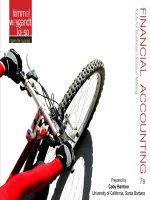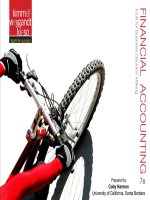bg financial accounting 2 chapter 12 5715
Bạn đang xem bản rút gọn của tài liệu. Xem và tải ngay bản đầy đủ của tài liệu tại đây (485.66 KB, 36 trang )
175
CHAPTER 12: FINANCIAL STATEMENTS
12.1 Overview of financial statements
12.2 Accounting asssumptions and principle for financial reporting
12.3 Statement of financial position
12.4 Statement of comprehensive income
12.5 Statement of Cash Flows
12.6 Statement of changes in equity
12.7 Notes to Financial statements
FINANCIAL ACCOUNTING 2
176
CHAPTER 12: FINANCIAL STATEMENTS
OBJECTIVE: After studying this chapter, you should be able to:
Identify the main financial statements and their purpose
Understand how to prepare Statement of financial position, Statement
of comprehensive income, Statement of Cash Flows, Statement of
changes in equity and Notes to Financial statements
FINANCIAL ACCOUNTING 1
12.1.Overview of financial statements
12.1.1.Definition of financial statements
12.1.2.Types of financial statements
177
FINANCIAL ACCOUNTING 2
12.1.1.DEFINITION OF FINANCIAL STATEMENTS
• The financial statements provide information about an entity's
assets, liabilities, equity, income and expenses that is useful to
financial statements users in assessing the prospects for future
net cash inflows to the entity and in assessing management's
stewardship of the entity's resources
• The financial statements of limited liability companies are
usually governed by national legislation and accounting
standards.
• From an international standpoint, however, the general content
of financial statements is governed by IAS 1 Presentation of
financial statements
12.1.1.DEFINITION OF FINANCIAL STATEMENTS
• The primary users of general purpose financial reporting are
present and potential investors, lenders and other creditors, who
use that information to make decisions about buying, selling or
holding equity or debt instruments, providing or settling loans or
other forms of credit, or exercising rights to vote on, or
otherwise influence, management’s actions that affect the use of
the entity’s economic resources
12.1.1.DEFINITION OF FINANCIAL STATEMENTS
The entity should identify each component of the financial statements very clearly. IAS 1
also requires disclosure of the following information in a prominent position.
• Name of the reporting entity (or other means of identification)
• Whether the accounts cover the single entity only or a group of entities
• The reporting date or the period covered by the financial statements (as appropriate)
• The reporting currency used in presenting the figures in the financial statements
• Reporting period: Entities normally present financial statements annually. IAS 1 states
that they should be prepared at least as often as this
12.1.2.TYPES OF FINANCIAL STATEMENTS
A complete set of financial statements includes the following.
• Statement of financial position
• Statement of profit or loss and other comprehensive income
(either as a single statement or as two separate statements: the
statement of profit or loss and the statement of other
comprehensive income)
• Statement of changes in equity
• Statement of cash flows
• Notes, including a summary of significant accounting policies
and other explanatory information
12.2.Accounting asssumptions and principle for financial reporting
12.2.1.Accounting assumptions
12.2.2.Accounting principles
182
FINANCIAL ACCOUNTING 2
12.2.1.ACCOUNTING ASSUMPTIONS
Underlying assumption
•The IFRS Framework states that the going concern assumption is
an underlying assumption
•The going concern basis of accounting is the assumption in
preparing the financial statements that an entity will continue in
operation for the foreseeable future and does not plan to go into
liquidation, and will not be forced into liquidation or to curtail its
operations.
Thus, the financial statements presume that an entity will
continue in operation indefinitely or, if that presumption is not
valid, disclosure and a different basis of reporting are required
Note: they may require valuation of assets on a break-up basis if
the company will cease trading.
12.2.1.ACCOUNTING ASSUMPTIONS
Accrual assumption
•Under the accrual basis, the effects of transactions and other
events are recognised when they occur, and not as cash is received
or paid. Under the accruals basis, events are recorded in the
accounting records and reported in the financial statements of the
periods to which they relate.
Financial statements prepared on the accrual basis inform users
not only to past transactions when cash was paid or received but
also of obligations to pay cash in the future and of cash or its
equivalents to be received in the future
12.2.2.ACCOUNTING PRINCIPLES
Accounting principles
• Fair presentation
• Consistency of presentation
• Business entity concept
• Materiality and aggregation
• Offsetting
• Cost concept
12.3 Statement of financial position
12.3.1 Overview of the statement of financial position
12.3.2 Preparation of the statement of financial position
186
FINANCIAL ACCOUNTING 2
12.3.1 OVERVIEW OF STATEMENT OF FINANCIAL POSITION
187
Statement of
financial position
FINANCIAL ACCOUNTING 2
• A list of all the assets controlled and all the
liabilities owed by a business as at a
particular date: it is snapshot of the
financial position of the business at a
particular moment. Monetary amounts are
attributed to assets and liabilities. It also
quantifies the amount of the owners’
interest in the company: equity.
12.3.1 OVERVIEW OF STATEMENT OF FINANCIAL POSITION
188
SOFP
Certain line items MUST be presented in the statement of financial
position.
• assets held for sale
property, plant and
equipment
• trade and other payables
investment property
• provisions
intangible assets
• financial liabilities
financial assets
• current tax amounts
equity accounted investments • deferred tax amounts
• liabilities held for sale
biological assets
• non-controlling interests
inventories
• issued capital and reserves.
trade and other receivables
cash and cash equivalents
12.3.1 OVERVIEW OF STATEMENT OF FINANCIAL POSITION
Statement of
financial position
• CONCEPT:The statement of financial
position makes use of the accounting
equation
concept
that:ASSETS
=
CAPITAL + LIABILITIESThe statement of
financial position is also prepared
according to the business entity
convention, that a business is separate
from its owners
FINANCIAL ACCOUNTING 2
189
12.3.1 OVERVIEW OF STATEMENT OF FINANCIAL POSITION
190
Some definitions
Asset
• is a resource controlled by the entity as a result
of past events and from which future economic
benefits are expected to flow to the entity.
A liability
• is a present obligation of the entity arising from
past events, the settlement of which is expected
to result in an outflow from the entity of
resources embodying economic benefits.
Equity
• is the residual interest in the assets of the entity
after deducting all its liabilities. Equity is also
the amount invested in a business by the owners.
FINANCIAL ACCOUNTING 2
191
12.3.2
Preparation of the statement of financial position
Some definitions
FINANCIAL ACCOUNTING 2
12.4 Statement of comprehensive income
12.4.1 Overview of the statement of comprehensive income
12.4.2 Preparation of the statement of comprehensive income
192
FINANCIAL ACCOUNTING 2
12.4.1 OVERVIEW OF THE STATEMENT OF COMPREHENSIVE INCOME
193
Statement of of
comprehensive
income
• A statement displaying items of
income and expense in a reporting
period as components of profit or loss
for the period.
• The statement shows whether the
business has had more income than
expense (a profit for the period) or vice
versa (a loss for the period)
The link between the statement of financial position and
the statement of of comprehensive income is provided by the
statement
of cash flows and the statement of changes in
FINANCIAL ACCOUNTING 2
equity
12.4.1 OVERVIEW OF THE STATEMENT OF COMPREHENSIVE INCOME
194
Information about the business's financial is needed by users.
• To understand the return that the entity has produced on its
economic resources
• To assess how well management has discharged its
responsibilities to make efficient and effective use of the
reporting entity’s resources
• To help predict the business's future returns on its economic
resources
FINANCIAL ACCOUNTING 2









